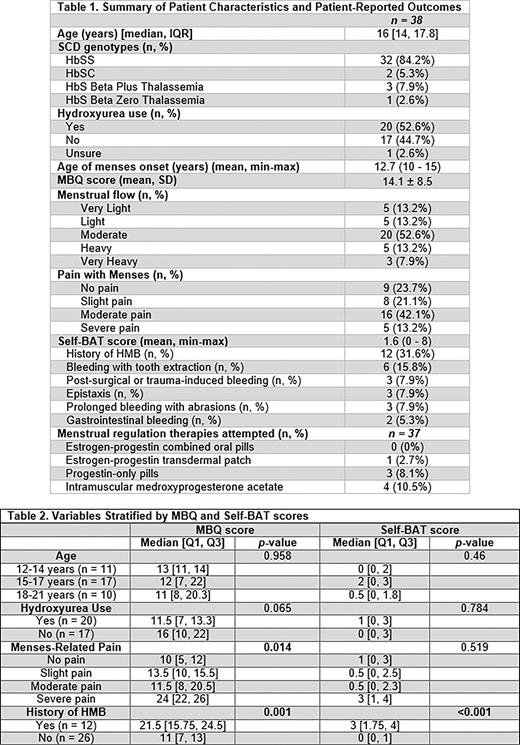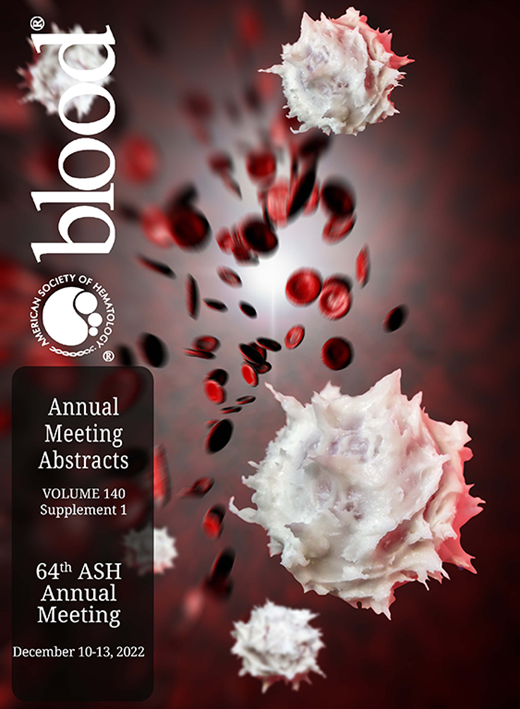Abstract
Introduction: Sickle Cell Disease (SCD) is traditionally associated with thrombotic events such as venous thromboembolism and cerebrovascular events. However, adults with SCD have an increased cumulative incidence of bleeding complications by 40 years of age, including heavy menstrual bleeding (HMB). HMB affects 40% of adolescent girls in the general population and is a common reason for referral to pediatric hematology clinics. Whether adolescent girls and young women with SCD are similarly affected by HMB and other bleeding manifestations have not been well described. This purpose of this study was to assess the menstrual health status of this population and to estimate the prevalence of HMB and other bleeding symptoms.
Methods: Menarchal adolescent girls and young women aged 12-21 years old, diagnosed with any SCD genotype, and followed in one of three pediatric hematology clinics at a large tertiary care children's hospital were approached for a cross-sectional study. The study consisted of a 5-part questionnaire administered through the Research Electronic Data Capture (REDCap) system. The questionnaire included collection of demographic information, menstrual health knowledge assessment, menstrual bleeding medication rating profile, and validated instruments for patient-reported HMB outcomes and historical bleeding symptoms. The patient-reported outcome instruments consisted of the one-month recall Menstrual Bleeding Questionnaire (MBQ) and Self-Administered Bleeding Assessment Tool (Self-BAT). Statistical procedures involved chi-squared test and Kruskal-Wallis test. Statistical significance was set at p<0.05.
Results: To date, 38 participants have completed the questionnaire. The mean age of the study cohort was 15.9 ± 2.3 years. Individuals with SCD genotype HbSS comprised the majority of the cohort and 53% (n = 20) reported hydroxyurea use (Table 1). Mean age of menarche was 13 years (min-max 10-15 years). On the menstrual health knowledge assessment, 6 participants (16%) correctly identified all four characteristics of normal menstruation per American College of Obstetricians and Gynecologists (ACOG) definitions. Specifically, 50% correctly identified the expected duration of menses and 45% identified all of the pharmacologic categories available for menstrual regulation. Parents/guardians were the primary source of menstrual health knowledge (84%), while social media/internet was the predominant secondary source (29%). The mean MBQ score was 14.1 ± 8.5. For comparison, the MBQ validation study performed in adult women with and without HMB reported a mean MBQ score of 30.8 ± 14 and 10.6 ± 8.6, respectively. Approximately 55% of participants reported moderate or severe pain related to menstrual cycles. Pain was not significantly associated with age, hydroxyurea use, or self-reported history of HMB. Ibuprofen (16%) and acetaminophen (11%) were the main medications listed for menstrual pain relief. For the Self-BAT, abnormal bleeding scores are classified as ≥3 in children and ≥6 in women. The cohort mean Self-BAT score was 1.6 (min-max 0-8) and 29% (n = 11) had abnormal bleeding scores. Bleeding symptoms reported were post-surgical/trauma-induced bleeding, epistaxis, prolonged bleeding from small cuts, and bleeding after tooth extraction. Interestingly, 12 participants (32%) reported a history of HMB on the Self-BAT. There were no significant differences in MBQ or Self-BAT scores by age and hydroxyurea use, although individuals with HMB had significantly higher MBQ and Self-BAT scores (Table 2). Six participants (50%) with HMB attempted ≥1 hormonal therapy method for menstrual regulation. One additional participant without HMB received hormonal therapy.
Conclusions: In this study, we demonstrate that 32% of adolescent girls and young women with SCD reported a history of HMB and the majority of participants reported moderate/severe pain related to their menstrual cycle. Yet, only 50% with HMB attempted a hormonal therapy. Furthermore, most of the participants had reduced knowledge of normal menstrual health. These findings suggest a critical need for improved education and patient/provider discussion regarding menstruation. Ultimately, incorporating menstrual health assessment into SCD care is important for optimizing patient health and addressing health inequities in the adolescent and SCD population.
Disclosures
Tickle:National Hemophilia Foundation: Research Funding, Speakers Bureau; Dudley Nursing Research Fund: Research Funding; HFA: Membership on an entity's Board of Directors or advisory committees. Sidonio, Jr.:Sobi: Consultancy; Catalyst: Consultancy; Biomarin: Consultancy; Sanofi: Consultancy; Takeda: Consultancy, Research Funding; Novo Nordisk: Consultancy; Genentech: Consultancy, Research Funding; Octapharma: Consultancy, Research Funding; Bayer: Consultancy; Pfizer: Consultancy; Grifols: Consultancy, Research Funding; Kedrion: Consultancy; HEMA Biologics: Consultancy. Batsuli:Bio Product Laboratory: Honoraria; Kedrion: Honoraria.
Author notes
Asterisk with author names denotes non-ASH members.


